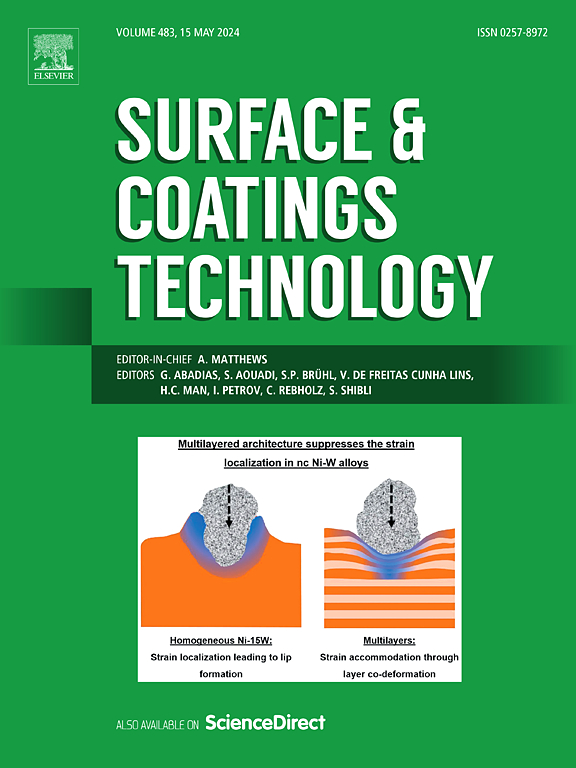用氦离子显微镜研究等离子体聚合物薄膜对多孔硅的渗透
IF 5.3
2区 材料科学
Q1 MATERIALS SCIENCE, COATINGS & FILMS
引用次数: 0
摘要
等离子体聚合是一种薄膜沉积技术,经常用于各种生物医学和工业应用的表面修饰。许多材料都有一定程度的孔隙度,一般来说,等离子体聚合物薄膜如何有效地穿透不同孔径的孔隙还不是很清楚。在孔径分别为13-25 nm、32-58 nm、120-180 nm和0.9-1.2 μm的多孔硅(pSi)衬底上沉积了厚度分别为50、100和150 nm的等离子体聚合丙烯酸(ppAAc)薄膜,研究了孔径大小与薄膜穿透孔的关系。薄膜化学性质用x射线光电子能谱进行表征,而与pSi衬底同时沉积的无孔衬底上的薄膜厚度用光谱椭偏仪测量。利用氦离子显微镜(he)对pSi衬底上的ppAAc薄膜进行成像,并测定薄膜厚度。对于孔径为180 nm的三种pSi衬底,在HIM图像中观察到薄膜在孔中的渗透可以忽略不计。当ppAAc膜的直径大于最大孔的直径时,可以观察到连续膜完全堵塞孔。对于孔径为0.9 ~ 1.2 μm的pSi,在孔内2 μm处可见ppAAc膜;这些结果表明了等离子体聚合物薄膜渗透到多孔结构中所需的孔径尺度,这是在任何应用中将等离子体聚合物涂层应用于多孔基板时需要考虑的重要因素。本文章由计算机程序翻译,如有差异,请以英文原文为准。

Investigating the penetration of a plasma polymer film into porous silicon with helium ion microscopy
Plasma polymerisation is a thin film deposition technique that is frequently used to modify surfaces for a variety of biomedical and industrial applications. Many materials have some degree of porosity and generally it is not well understood how effectively plasma polymer films penetrate pores with varying pore diameters. Plasma polymerised acrylic acid (ppAAc) films with thicknesses of approximately 50, 100 and 150 nm were deposited onto four porous silicon (pSi) substrates with pore sizes of 13–25 nm, 32–58 nm, 120–180 nm and 0.9–1.2 μm, to investigate the relationship between pore size and film penetration into the pores. Film chemistry was characterised by X-ray photoelectron spectroscopy while film thicknesses on non-porous substrates deposited at the same time as the pSi substrates were measured using spectroscopic ellipsometry. Helium ion microscopy (HIM) was used to image the ppAAc films on the pSi substrates and also to determine film thickness. For the three pSi substrates, with pores diameters <180 nm, negligible film penetration into the pores was observed in the HIM images. Continuous films were observed, completely occluding the pores when the ppAAc films were thicker than the diameter of the largest pores. For pSi with pore diameters of 0.9–1.2 μm, ppAAc film was observed up to 2 μm inside the pore. These results indicate the pore size scales required for the penetration of plasma polymer films into a porous structure, which is an important consideration when applying plasma polymer coatings to porous substrates for any application.
求助全文
通过发布文献求助,成功后即可免费获取论文全文。
去求助
来源期刊

Surface & Coatings Technology
工程技术-材料科学:膜
CiteScore
10.00
自引率
11.10%
发文量
921
审稿时长
19 days
期刊介绍:
Surface and Coatings Technology is an international archival journal publishing scientific papers on significant developments in surface and interface engineering to modify and improve the surface properties of materials for protection in demanding contact conditions or aggressive environments, or for enhanced functional performance. Contributions range from original scientific articles concerned with fundamental and applied aspects of research or direct applications of metallic, inorganic, organic and composite coatings, to invited reviews of current technology in specific areas. Papers submitted to this journal are expected to be in line with the following aspects in processes, and properties/performance:
A. Processes: Physical and chemical vapour deposition techniques, thermal and plasma spraying, surface modification by directed energy techniques such as ion, electron and laser beams, thermo-chemical treatment, wet chemical and electrochemical processes such as plating, sol-gel coating, anodization, plasma electrolytic oxidation, etc., but excluding painting.
B. Properties/performance: friction performance, wear resistance (e.g., abrasion, erosion, fretting, etc), corrosion and oxidation resistance, thermal protection, diffusion resistance, hydrophilicity/hydrophobicity, and properties relevant to smart materials behaviour and enhanced multifunctional performance for environmental, energy and medical applications, but excluding device aspects.
 求助内容:
求助内容: 应助结果提醒方式:
应助结果提醒方式:


